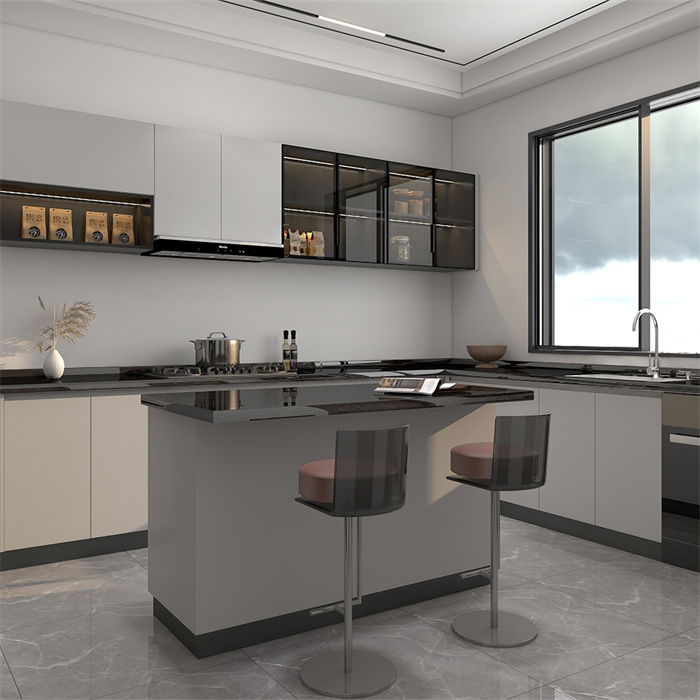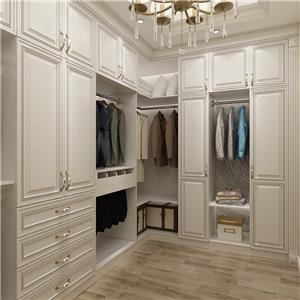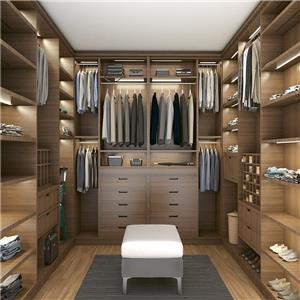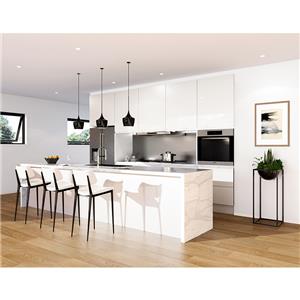Modern Designs for Kitchen Cabinets: A Comprehensive Exploration
Modern Designs for Kitchen Cabinets: A Comprehensive Exploration
Introduction
The kitchen is often considered the heart of the home, and kitchen cabinets play a pivotal role in defining its functionality, style, and overall aesthetic. In contemporary times, modern kitchen cabinet designs have evolved significantly, incorporating innovative concepts, materials, and technologies. These designs not only focus on providing ample storage space but also on enhancing the visual appeal and user - friendliness of the kitchen. Whether you are planning a new kitchen renovation or looking to update your existing cabinets, understanding modern kitchen cabinet designs is essential. This article delves deep into the various aspects of modern kitchen cabinet designs, from their diverse styles and materials to the latest trends and considerations for choosing the perfect cabinets for your kitchen.
Styles of Modern Kitchen Cabinets
Minimalist Style
Clean Lines and Simplicity
Minimalist kitchen cabinets are characterized by their sleek, straight lines and lack of ornate details. The doors typically feature flat panels, either in a smooth finish or with a very subtle texture. This simplicity gives the kitchen a clean, uncluttered look, making it ideal for those who prefer a modern, streamlined aesthetic. For example, a kitchen with all - white, flat - panel minimalist cabinets can create a bright, airy space that feels both spacious and sophisticated.
Handle - less designs are a common feature in minimalist cabinets. Instead of traditional knobs or pulls, these cabinets may have recessed handles, push - to - open mechanisms, or grooves in the cabinet doors that allow for easy opening. This further contributes to the seamless and minimalist appearance, eliminating any visual distractions.
Neutral Color Palette
Minimalist kitchen cabinets often come in a neutral color palette, with white, gray, and black being the most popular choices. White cabinets can make a small kitchen appear larger and brighter, while gray offers a more understated and sophisticated look. Black cabinets, when used sparingly or in combination with lighter colors, can add a touch of elegance and drama. For instance, a two - tone minimalist kitchen with white upper cabinets and black lower cabinets can create a striking visual contrast.
Industrial Style
Exposed Materials and Raw Finishes
Industrial - style kitchen cabinets embrace the use of raw and unfinished materials. Metal, such as stainless steel or iron, is a common choice for cabinet frames and handles. Exposed wooden shelves or cabinets with a distressed or reclaimed wood finish are also characteristic of this style. The combination of these materials gives the kitchen an edgy, urban feel. For example, a kitchen with stainless - steel cabinet frames and reclaimed - wood doors can evoke the look of a converted factory space.
Concrete is another material that is increasingly being used in industrial - style cabinetry. Concrete countertops or even entire cabinet fronts can add a unique, rugged texture to the kitchen. The rough, unfinished surface of concrete pairs well with the other raw materials in an industrial - style kitchen.
Function - Over - Form Aesthetic
Industrial - style kitchen cabinets prioritize functionality. They often feature open shelving, which allows for easy access to cookware, dishes, and utensils. This open layout also showcases the items stored in the cabinets, adding to the industrial, utilitarian look. Additionally, industrial - style cabinets may have large, heavy - duty drawers or pull - out shelves, which are suitable for storing bulky items like pots, pans, and baking sheets.
Scandinavian Style
Light - Filled and Airy Spaces
Scandinavian - style kitchen cabinets are designed to create a light - filled and airy atmosphere. Light - colored woods, such as pine, birch, or white - washed oak, are commonly used. These woods not only provide a warm and natural look but also reflect light, making the kitchen feel brighter and more spacious. For example, a kitchen with white - washed oak cabinets and light - colored countertops can create a cozy yet open environment.
Scandinavian - style cabinets often have a simple, unadorned design. The doors may be flat - panel or have a very basic raised - panel design. The simplicity of the cabinets allows the natural beauty of the wood to shine through.
Functional and Ergonomic Design
Functionality is a key aspect of Scandinavian - style kitchen cabinets. They are designed with the user in mind, with features such as well - organized storage compartments, pull - out drawers, and adjustable shelves. Ergonomic considerations are also important, with cabinets being installed at heights that are comfortable for users to reach and access items. For instance, a Scandinavian - style kitchen may have lower - level cabinets with pull - out drawers for easy access to pots and pans, and upper - level cabinets with adjustable shelves to accommodate different - sized items.
Materials Used in Modern Kitchen Cabinets
Wood
Solid Wood
Solid wood is a classic and durable material for kitchen cabinets. Woods like oak, maple, cherry, and walnut are highly popular. Solid - wood cabinets offer a natural, warm look that can enhance the aesthetic of any kitchen. Oak, for example, has a distinct grain pattern that adds character to the cabinets. Cherry wood darkens over time, developing a rich, luxurious patina.
Solid - wood cabinets can be stained or painted to match any color scheme. They are also highly durable and can withstand the wear and tear of daily use in the kitchen. However, they tend to be more expensive compared to some other materials.
Plywood and MDF
Plywood is a popular alternative to solid wood. It is made by gluing together multiple layers of thin wood veneers. Plywood is strong, stable, and less likely to warp or crack compared to solid wood. It can be used for the cabinet boxes and is often covered with a veneer or painted finish.
Medium - density fiberboard (MDF) is another commonly used material. MDF is made from wood fibers and resin, and it has a smooth, uniform surface. It is an affordable option and can be easily painted or laminated. MDF is often used for cabinet doors and drawer fronts, especially in modern, flat - panel designs.
Laminate
Variety of Colors and Patterns
Laminate is a versatile material that comes in a wide range of colors, patterns, and textures. It can mimic the look of wood, stone, or even metal, allowing for a more affordable way to achieve a high - end aesthetic. For example, there are laminate options that closely resemble the grain of oak or the veining of marble.
Laminate is also available in high - gloss and matte finishes. High - gloss laminate can add a sleek, modern touch to the kitchen, while matte laminate offers a more subdued, sophisticated look.
Durability and Easy Maintenance
Laminate is highly durable and resistant to scratches, stains, and moisture. This makes it an ideal choice for kitchen cabinets, as kitchens are prone to spills and splashes. Cleaning laminate cabinets is relatively easy; a simple wipe with a damp cloth is usually sufficient. Laminate is also less expensive than many other cabinet materials, making it a popular option for budget - conscious homeowners.
Metal
Stainless Steel
Stainless - steel cabinets are a popular choice for modern and industrial - style kitchens. Stainless steel is known for its durability, resistance to corrosion, and sleek, contemporary look. It can give the kitchen a high - tech, professional appearance. Stainless - steel cabinets are often used in commercial - style kitchens or in modern homes where a bold, industrial aesthetic is desired.
Stainless - steel cabinets can be paired with other materials, such as wood or glass, to create a unique and visually interesting look. For example, stainless - steel cabinet frames combined with reclaimed - wood doors can add warmth and texture to the otherwise cold and sleek metal.
Aluminum
Aluminum is a lightweight and corrosion - resistant metal that is also used in kitchen cabinetry. It is often used in modern, minimalist designs. Aluminum cabinets can be powder - coated in a variety of colors, allowing for customization. They are also relatively easy to clean and maintain, making them a practical choice for kitchens.
Functional Features of Modern Kitchen Cabinets
Smart Storage Solutions
Pull - Out Shelves and Drawers
Pull - out shelves and drawers are a popular functional feature in modern kitchen cabinets. These allow for easy access to items stored at the back of the cabinet, eliminating the need to rummage through piles of cookware or food items. Pull - out shelves can be installed in base cabinets, wall cabinets, or even in pantry cabinets. For example, a base cabinet with pull - out shelves can be used to store pots, pans, and baking sheets, making it easy to find and retrieve the items you need.
Drawers with dividers are also a great way to organize utensils, cutlery, and small kitchen tools. The dividers keep the items separate and prevent them from getting jumbled together, making it easier to find what you need at a glance.
Corner Storage Solutions
Corner cabinets often present a challenge when it comes to storage, but modern designs offer several solutions. Lazy Susans are a classic option for corner cabinets. These rotating shelves allow for easy access to items stored in the corner. Another option is a pull - out corner cabinet, which has shelves that slide out from the corner, providing full access to the storage space. Some corner cabinets also come with specialized dividers or racks for storing specific items like wine bottles or spice jars.
Integrated Appliances
Sleek and Seamless Look
Integrating appliances into kitchen cabinets is a popular trend in modern kitchen design. This creates a sleek and seamless look, where the appliances blend in with the cabinetry, giving the kitchen a more cohesive and streamlined appearance. For example, a refrigerator can be built into a cabinet, with the cabinet doors covering the front of the fridge, making it look like just another part of the cabinetry.
Dishwashers and ovens can also be integrated into the cabinets. This not only improves the aesthetics of the kitchen but also allows for better use of space. Integrated appliances can be customized to match the style and color of the cabinets, creating a harmonious look.
Enhanced Functionality
Integrated appliances can also enhance the functionality of the kitchen. For example, a built - in oven can be installed at a height that is convenient for the user, reducing the need to bend down or reach up. Some integrated appliances also come with advanced features, such as smart technology that allows you to control the appliance from your smartphone or voice - activated commands.
Adjustable Shelving
Customizable Storage
Adjustable shelving is a highly practical feature in modern kitchen cabinets. It allows you to customize the storage space according to your needs. You can move the shelves up or down to accommodate different - sized items, whether it's large pots and pans or small spice jars. Adjustable shelving is particularly useful in pantry cabinets, where the storage needs can vary depending on the types of food items you store.
Some modern cabinets come with shelves that can be adjusted without the need for tools. These shelves may have a clip - on or snap - on mechanism that allows for easy repositioning. This makes it convenient to change the storage layout as your needs change over time.
Layout Considerations for Modern Kitchen Cabinets
Open - Concept Kitchens
Integration with Living Spaces
Open - concept kitchens are a popular trend in modern home design, and the layout of kitchen cabinets plays a crucial role in this design. In an open - concept kitchen, the cabinets are often designed to flow seamlessly into the adjacent living or dining areas. This may involve using the same color or material for the cabinetry as in the other areas of the open space to create a cohesive look.
Kitchen islands are a common feature in open - concept kitchens. The island can have its own set of cabinets, which can be used for additional storage, as a prep area, or even as a breakfast bar. The cabinets on the island can be designed to match the main kitchen cabinets or can be a contrast to add visual interest.
Traffic Flow and Accessibility
When designing cabinets in an open - concept kitchen, it's important to consider the traffic flow. The cabinets should be placed in a way that allows for easy movement around the kitchen and between the kitchen and the other areas of the open space. There should be enough clearance around the cabinets, especially in areas where the cabinet doors or drawers will be opened.
Accessibility is also key. The cabinets should be installed at heights that are comfortable for all users to reach. In an open - concept kitchen, where there may be more people moving around, it's important to ensure that the cabinet doors and drawers don't obstruct the walkways.
Small Kitchens
Maximizing Space
In small kitchens, the layout of the cabinets is crucial for maximizing space. Wall - mounted cabinets can be installed to take advantage of vertical space, providing storage without taking up valuable floor space. Base cabinets with pull - out shelves and drawers can make the most of the limited horizontal space, allowing for easy access to items.
Corner cabinets in small kitchens should be designed with space - saving solutions, such as lazy Susans or pull - out corner units. These can make it easier to access the items stored in the corner, which is often a difficult - to - reach area in a small kitchen.
Light - Reflecting Surfaces
Choosing light - colored cabinet materials can help make a small kitchen appear larger. Light - colored cabinets, such as white or light gray, reflect light, creating an illusion of more space. Glossy finishes on the cabinets can also help to reflect light and make the kitchen feel brighter and more open. Additionally, using glass - fronted cabinets in a small kitchen can give the impression of more space, as they allow you to see through the cabinets, rather than creating a solid, closed - in look.
Trends in Modern Kitchen Cabinet Design
Sustainable and Eco - Friendly Designs
Use of Recycled and Renewable Materials
There is a growing trend towards using sustainable materials in modern kitchen cabinet design. Recycled materials, such as reclaimed wood or recycled plastic, are being used to create cabinets. Reclaimed wood not only gives the cabinets a unique, rustic look but also reduces the demand for new timber. Recycled plastic can be used to make cabinet components, such as drawer fronts or handles, and is a more environmentally friendly alternative to traditional plastics.
Renewable materials, such as bamboo, are also becoming increasingly popular. Bamboo is a fast - growing plant that is highly sustainable. Bamboo cabinets can have a modern, natural look and are a great choice for those who are environmentally conscious.
Energy - Efficient Features
Some modern kitchen cabinets are being designed with energy - efficient features. For example, cabinets with built - in LED lighting use less energy than traditional lighting options. LED lights can be installed inside the cabinets to provide illumination when the doors are opened, making it easier to find items. Additionally, some cabinets are designed to be more energy - efficient in terms of insulation, helping to keep the kitchen cool in the summer and warm in the winter, reducing the need for excessive heating or cooling.
Smart Cabinet Technology
Automated Features
Smart cabinet technology is another emerging trend in modern kitchen design. Some cabinets now come with automated features, such as push - to - open or close mechanisms. These eliminate the need for traditional handles and make it easier to access the cabinets, especially when your hands are full. Some cabinets also have self - closing drawers and doors, which close gently and quietly, preventing them from slamming shut.
There are also smart cabinets with built - in sensors. These sensors can detect when an item is running low in the cabinet, such as flour or sugar, and can send a notification to your smartphone. This helps with grocery shopping and ensures that you never run out of essential items.
Integration with Home Automation Systems
Modern kitchen cabinets are increasingly being integrated with home automation systems. This allows you to control the cabinets, as well as other kitchen appliances and devices, from a single interface, such as your smartphone or a smart home hub. For example, you can use your smartphone to open or close the cabinet doors, adjust the lighting inside the cabinets, or even turn on the oven or dishwasher that is integrated into the cabinetry.





